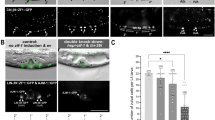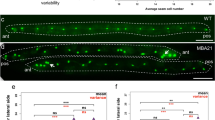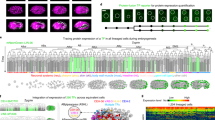Abstract
IN certain multicellular organisms, genetic regulatory systems that specify the timing of cell division, differentiation and morpho-genesis1–3 must accommodate environmental and physiological contingencies that perturb or arrest development. For example, Caenorhabditis elegans can either develop continuously through four larval stages (L1–L4) or arrest indefinitely as a 'dauer larva' at the second larval (L2) moult, and later resume L3 and L4 development4–7. At the larva-to-adult (L4) moult of both con-tinuous and 'post-dauer' development, hypodermal cells switch (the 'L/A switch') from a proliferating state to the terminally differentiated state. Four temporal regulators, lin-4, lin-14, lin-28 and lin-29, have been identified in C. elegans by mutations that cause precocious or retarded expression of stage-specific post-embryonic development events, including the L/A switch (refs 3, 8, 9; Fig. la). These genes have been organized into a genetic pathway that controls the timing of the L/A switch during continuous development10: lin-29 activates the switch and the other heterochronic genes regulate it indirectly by regulating lin-29. We have now examined how the proper timing of this event is specified in alternative developmental pathways. In continuously developing lin-4, lin-14 and lin-28 mutants the L/A switch occurs at abnor-mally early or late moults3,8, but during post-dauer development of the same mutants the L/A switch occurs normally. Thus hypodermal cell differentiation is regulated by separate temporal control systems, depending on the developmental history.
This is a preview of subscription content, access via your institution
Access options
Subscribe to this journal
Receive 51 print issues and online access
$199.00 per year
only $3.90 per issue
Buy this article
- Purchase on Springer Link
- Instant access to full article PDF
Prices may be subject to local taxes which are calculated during checkout
Similar content being viewed by others
References
Alberch, P., Gould, S. J., Oster, G. F. & Wake, D. B. Paleobiology 5, 296–317 (1979).
Gould, S. J. Ontogeny and Phylogeny (Harvard University Press, Cambridge, Massachusetts, 1977).
Ambros, V. & Horvitz, H. R. Science 226, 409–416 (1984).
Cassada, R. C. & Russell, R. L. Devl Biol. 46, 326–342 (1975).
Evans, A. A. F. & Perry, R. M. in The Organization of Nematodes (ed. Croll, N. A.) (Academic, New YorK, 1976).
Golden, J. M. & Riddle, D. L. Science 218, 578–580 (1987).
Riddle, D. L. in The Nematode Caenorhabditis elegans (eds Wood, W. B. and the community of C. elegans researchers) (Cold Spring Harbor Laboratory, New York, 1988).
Chalfie, M., Horvitz, R. H. & Sulston, J. E. Cell 24, 59–69 (1981).
Ambros, V. & Horvitz, H. R. Genes Dev. 1, 398–414 (1987).
Ambros, V. Cell 57, 49–57 (1989).
Riddle, D. L., Swanson, M. M. & Alberts, P. S. Nature 290, 668–671 (1981).
Liu, Z. & Ambros, V. Genes. Dev. 3, 2039–2049 (1989).
Cox, G. N., Fields, C., Kramer, J. M., Rosenzweig, B. & Hirsh, D. Gene 76, 331–344 (1989).
Cox, G. N. & Hirsh, D. Molec. cell. Biol. 5, 363–372 (1985).
Ferguson, E. & Horvitz, H. R. Genetics 110, 17–72 (1985).
Cox, G. N., Laufer, J. S. Kusch, M. & Edgar, R. Genetics 95, 317–339 (1980).
Ruvkun, G. & Guisto, J. Nature 338, 313–319 (1989).
Sulston, J. E. & Horvitz, R. H. Devl Biol. 56, 110–156 (1977).
Kramer, J. M., French, R. P., Park, E. & Johnson, J. J. Molec. cell. Biol. 10 (1990).
Fire, A., Harrison, S. & Dixon, D. Gene 93, 189–198 (1990).
Author information
Authors and Affiliations
Rights and permissions
About this article
Cite this article
Liu, Z., Ambros, V. Alternative temporal control systems for hypodermal cell differentiation in Caenorhabditis elegans. Nature 350, 162–165 (1991). https://doi.org/10.1038/350162a0
Issue Date:
DOI: https://doi.org/10.1038/350162a0
This article is cited by
-
Genetic control of macro-and micro-environmental sensitivities in Populus
Theoretical and Applied Genetics (1997)
-
Gene regulation, quantitative genetics and the evolution of reaction norms
Evolutionary Ecology (1995)
Comments
By submitting a comment you agree to abide by our Terms and Community Guidelines. If you find something abusive or that does not comply with our terms or guidelines please flag it as inappropriate.



